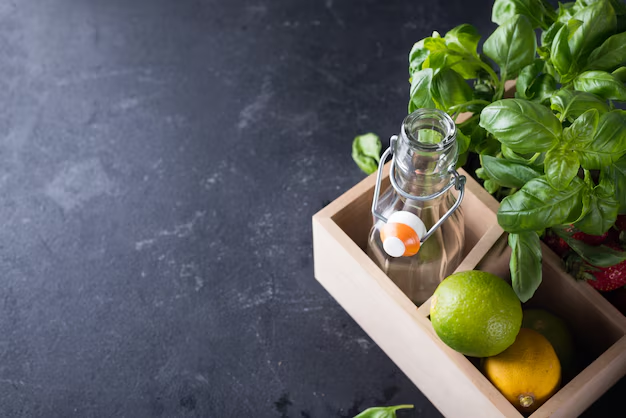The Ultimate Guide to Keeping Your Fresh Herbs Crisp: Tips and Tricks for Refrigerator Storage
Imagine a fragrant bunch of basil or a bouquet of cilantro in your kitchen, freshly picked and begging to be turned into a delicious meal. Fresh herbs are not only a delightful addition to our recipes, but they are also loaded with flavors that elevate even the simplest dishes. However, keeping these vibrant greens fresh in your refrigerator can be a challenge. In this comprehensive guide, we’ll explore how to preserve fresh herbs in the refrigerator effectively and efficiently. Whether you're a seasoned cook or a budding home chef, you'll find these insights invaluable.
🌿 Understanding the Needs of Different Herbs
Before diving into preservation techniques, it's crucial to understand that different herbs have different needs. Herbs can broadly be classified into two categories: soft and delicate (like basil and cilantro) and hard and woody (such as rosemary and thyme).
Soft Herbs
- Characteristics: Soft herbs are tender, have high moisture content, and often require a gentle hand. Examples include basil, mint, parsley, cilantro, and dill.
- Storage Needs: These herbs thrive in a moist, cool environment that mimics their native growing conditions.
Hard Herbs
- Characteristics: Hard herbs are robust, usually with woody stems and a lower moisture content. Common types include rosemary, thyme, sage, and oregano.
- Storage Needs: Hard herbs prefer to be kept relatively dry and can handle cooler temperatures slightly better than their soft counterparts.
Understanding these distinctions is essential for applying the right preservation methods.
🛍️ How to Buy and Prepare Fresh Herbs for Storage
Ensuring your herbs stay fresh begins at the purchase point. Here’s how you can start right:
- Select the Best: Choose herbs that are vibrant in color and aroma with no signs of wilting or browning.
- Prep Immediately: Once home, remove any damaged leaves and rinse your herbs gently under cold water to rid them of any dirt or insects.
- Dry Thoroughly: Use a clean kitchen towel or salad spinner to dry the leaves gently, as excess moisture can lead to spoilage.
🥶 Storing Fresh Herbs in the Refrigerator
Now that you're prepared, let's move on to the specifics of storing different types of herbs within the refrigerator.
Storage Techniques for Soft Herbs
Moisture Retention Method:
- What to Do: Fill a glass jar with about an inch of water, place the ends of the herb stems in the water, and cover loosely with a plastic bag.
- Herbs for This Method: Ideal for cilantro, parsley, and basil.
- Benefits: Mimics the natural environment, keeping herbs hydrated and vibrant.
Damp Paper Towel Method:
- What to Do: Wrap herbs in a damp paper towel and place them inside a loose plastic bag or an airtight container.
- Herbs for This Method: Suitable for delicate herbs like chives and dill.
- Benefits: Maintains moisture without oversaturating.
Storage Techniques for Hard Herbs
Dry Paper Towel Method:
- What to Do: Wrap hard herbs in a dry paper towel and store in a plastic bag or an airtight container.
- Herbs for This Method: Perfect for thyme, rosemary, and sage.
- Benefits: Prevents excess moisture which can cause mold.
Freezer Storage:
- Consider: Although typically kept in the refrigerator, some hard herbs like rosemary and thyme can also be frozen if long-term storage is needed.
- What to Do: Wash, dry, and place in a sealed freezer bag.
- Benefits: Extends storage life significantly.
🍃 Additional Tips for Prolonged Freshness
- Check Regularly: Regularly checking your herbs can prevent unwanted surprises. Remove any wilted or spoiled leaves immediately.
- Avoid Crushing: Ensure there’s ample space for herbs in the refrigerator; crushing can lead to quicker spoilage.
- Temperature Matters: Store herbs in the crisper drawer, where the temperature is more consistent and controlled.
✅ Quick Guide: Herb Preservation Techniques
Here’s a handy summary to keep your refrigerator herb game on point:
| Herb Type | Storage Method | Key Actions |
|---|---|---|
| Soft Herbs | Moisture Retention | Use water jars and a plastic bag cover |
| Damp Paper Towel | Wrap in damp paper towels in containers | |
| Hard Herbs | Dry Paper Towel | Wrap in dry paper towels in containers |
| Freezer Storage | For long-term storage, use freezer bags |
👨🍳 Creative Uses and Recipes
While preserving your herbs is crucial, knowing how to use them creatively will ensure none go to waste. Fresh herbs are versatile and can be incorporated into various dishes:
- Pestos and Sauces: Basil or parsley can transform into a fresh pesto.
- Infused Oils: Rosemary and thyme can create aromatic olive oils.
- Herb-Infused Vinegars: Tarragon or cilantro can add a new dimension to vinegars.
- Seasonal Salads: Fresh herbs can enhance any salad with their bursts of flavor.
🍽️ Benefits of Fresh Herbs in Cooking
Incorporating fresh herbs into your cooking offers benefits beyond just flavor enhancement:
- Nutritional Value: Fresh herbs can add essential vitamins and antioxidants to your diet.
- Aromatherapy: The aroma of fresh herbs can enhance mood and well-being, providing a sensory pleasure.
- Elegance in Presentation: Even a simple dish looks more refined with a sprinkle of fresh herbs.
🌟 Closing Insights
Preserving the vibrancy and flavor of fresh herbs in your refrigerator requires understanding their unique needs and applying the right techniques. By following these storage tips, selecting the best methods for each herb type, and creatively using these botanical wonders, you can ensure delicious, aromatic meals every time.
Experimenting with different preservation approaches will help you discover what works best for your cooking habits and refrigerator conditions. Enjoy the process of keeping your herbs fresh, and let their flavors inspire your culinary creations.
With your newfound knowledge, you're equipped to maximize the life and flavor of your herbs – take this guide to heart, and savor the freshness they bring to your kitchen! 🌿
